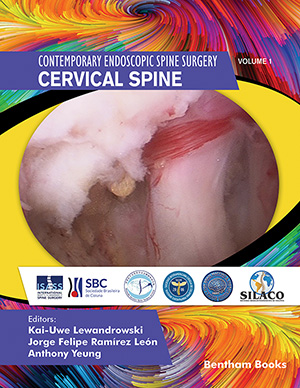Abstract
Cervical radiculopathy is a common disabling condition resulting from advanced degeneration of the cervical spine. Posterior Endoscopic Cervical Discectomy (PECD) surgery preserves soft tissue and accomplishes a form of foraminal decompression with a lower propensity to postoperative instability. The authors described the technique in detail with an illustrative case example and intraoperative endoscopic images. The targeting point is the “V” point made up by the lateral margin of interlaminar space and medial border of facet joint junction. This confluence of the medial junction of the superior and inferior facet can easily be recognized on AP view where it has the appearance of a V. Furthermore; the authors present the results of a prospective clinical PECD study of 29 levels in 25 patients where they analyzed the radiological and clinical outcome with the trans v point PECD technique. Most of the PECD surgeries were carried out at the C5/6 and C6/7 levels. The mean follow up was 29.6 months. There was a 4% complication rate because of motor deficits, which had been resolved after one year. The majority of patients showed significant improvements in VAS and ODI scores, and 96% achieved good and excellent results by Macnab’s criteria. Retrospective evaluation of the radiological and CT data showed sagittal foraminal area increase and craniocaudal foraminal length increases. PECD produced the largest foraminal length increase preferentially in the ventrodorsal direction. Based on our observations, PECD is a good option in the posterior foraminotomy of the cervical spine. Clinical and radiological outcomes are favorable.
Keywords: Cervical radiculopathy, Full endoscopic discectomy, Posterior cervical foraminotomy.






















